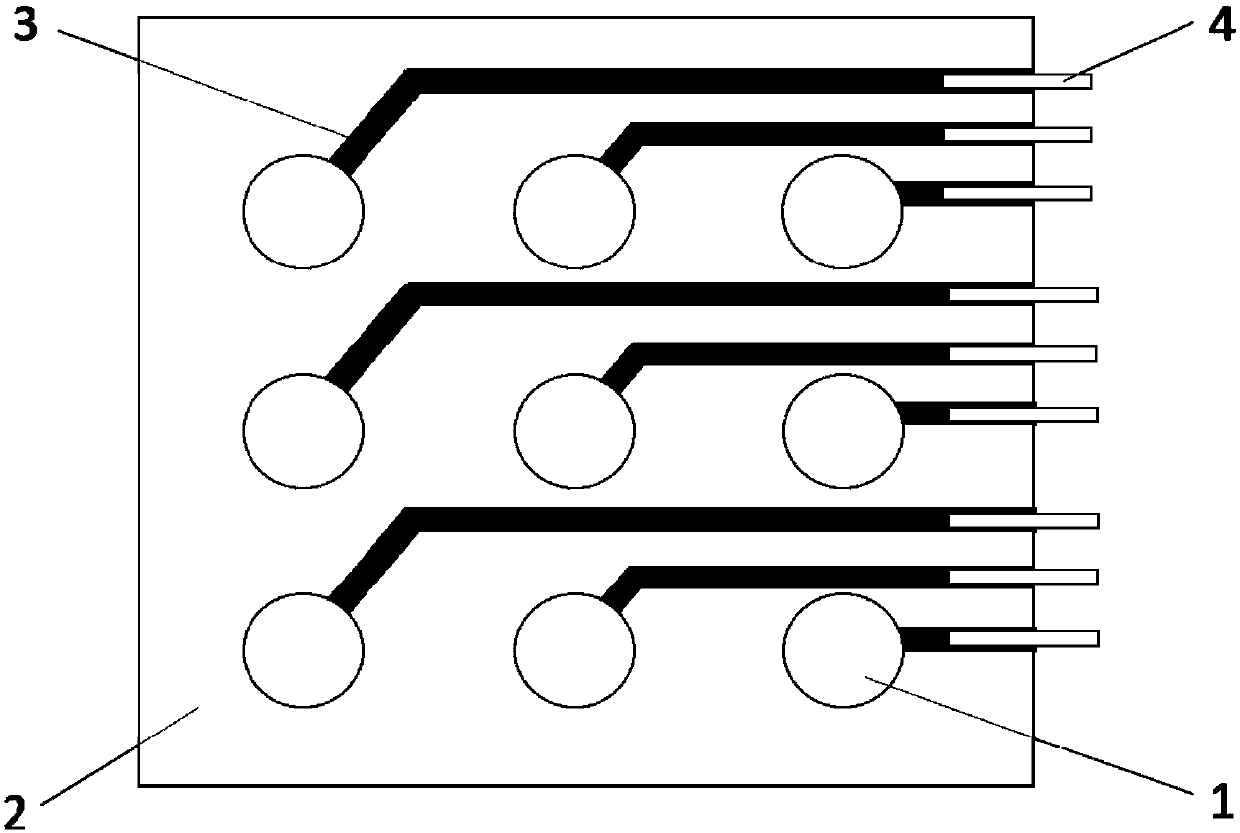Application of hydrogel in preparation of electrodes of cortex electrograph for detection
A technology for detecting cerebral cortex and hydrogel, which is applied in application, diagnostic recording/measurement, medical science, etc., can solve the problems of easily damaged brain tissue, poor biocompatibility, different conductive principles of the brain, etc., and achieve the reduction of colloid Cell production, good biocompatibility, effect of good biocompatibility
- Summary
- Abstract
- Description
- Claims
- Application Information
AI Technical Summary
Problems solved by technology
Method used
Image
Examples
Embodiment 1
[0028] Polyethylene glycol diacrylate was dissolved in cerebrospinal fluid, and an initiator was added to make a gel sheet 1, which was embedded in a flexible substrate 2 made of polydimethylsiloxane, and the pre-embedded silver sheet The inert metal sheet 3 is closely attached, and the inert metal sheet 3 is connected to the external instrument connector 4. made flexible electrodes such as figure 1 shown.
[0029] The above electrodes were placed in the brain of the mouse (strain C57), and after 3 weeks, the cortical field potential was connected to an external instrument detector, and the field potential signal was obtained as follows: image 3 shown.
[0030] Through the analysis of the field potential, it can be found that the field potential clearly shows the different activity states of the mouse, such as awake and sleeping. The experiment proves that the electrode is still usable after 2 weeks in the mouse body, and has good biocompatibility. The general electrocorti...
Embodiment 2
[0032] Polyethylene glycol diacrylate was dissolved in cerebrospinal fluid, and an initiator was added to make a gel, and the gel was injected into the brains of mice (strain C57). Filaments of platinum, the material used for conventional electrocorticography electrodes, were inserted into the brains of the same mice. Immunohistochemical staining was performed after 2 weeks to observe glial cell proliferation. Such as Figure 4 As shown, the left picture is the gel, and the right picture is the wire. Glial cells are excited to fluoresce under a microscope by a laser. It can be found that the glial cells of the gel are significantly less than those of the platinum wire. It shows that the gel has good biocompatibility in the brain environment.
Embodiment 3
[0034] Polyethylene glycol diacrylate was dissolved in cerebrospinal fluid, and an initiator was added to make a gel. The stress-strain curve of the gel measured with a tensile machine is as follows Figure 5 As shown, it can be obtained that the elastic modulus is 200Kpa, while the elastic modulus of the traditional metal electrode is on the order of 100Gpa, and the elastic modulus of the brain tissue is 10Kpa. This experiment proves that the elastic modulus of the gel is more compatible with the brain tissue, and the damage to the brain caused by the contact with the brain is smaller than that of the metal electrode.
PUM
| Property | Measurement | Unit |
|---|---|---|
| Elastic modulus | aaaaa | aaaaa |
| Elastic modulus | aaaaa | aaaaa |
| Elastic modulus | aaaaa | aaaaa |
Abstract
Description
Claims
Application Information
 Login to View More
Login to View More - R&D
- Intellectual Property
- Life Sciences
- Materials
- Tech Scout
- Unparalleled Data Quality
- Higher Quality Content
- 60% Fewer Hallucinations
Browse by: Latest US Patents, China's latest patents, Technical Efficacy Thesaurus, Application Domain, Technology Topic, Popular Technical Reports.
© 2025 PatSnap. All rights reserved.Legal|Privacy policy|Modern Slavery Act Transparency Statement|Sitemap|About US| Contact US: help@patsnap.com



